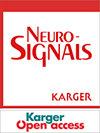血清脑源性神经营养因子和中枢n -乙酰天冬氨酸在抗抑郁药物治疗临床反应中的作用
Q1 Medicine
引用次数: 17
摘要
背景:脑源性神经营养因子(BDNF)的预测治疗价值及其变化与特定抗抑郁药的使用相关尚不清楚。在这项研究中,我们检查了BDNF作为抗抑郁药物治疗过程中的外周生物标志物和NAA作为中心生物标志物,以明确它们在药物反应和临床结果中的作用。方法:我们在自然环境中检测了76例抑郁症患者(47例女性,29例男性)的血清BDNF (ELISA试剂盒)。BDNF在药物治疗前以及随后的抗抑郁治疗2周、4周和6周后进行评估。此外,在15例患者中,用磁共振波谱(MRS)测量了n -乙酰天冬氨酸(NAA)在前扣带皮层(ACC)中的含量。在六周的时间里,41名健康对照者也接受了BDNF和NAA的检测。结果:我们发现抑郁症患者在服药前后血清BDNF浓度明显低于健康志愿者。患者的BDNF和临床症状在抗抑郁药物治疗过程中显著下降。基线血清BDNF水平预测8周后的症状结果。具体来说,应答者和缓解者在基线时的血清BDNF低于无应答者和无缓解者。与健康对照组相比,抑郁症患者的NAA略有下降,但没有显著降低。治疗期间,NAA呈增加趋势。局限性:相对较高的退出率,可能是BDNF的次优观察期。结论:我们的数据证实血清BDNF是抑郁症的生物标志物,可能在反应预测中起作用。然而,我们的研究结果反对血清BDNF的增加是抑郁症状减轻的先决条件。本文章由计算机程序翻译,如有差异,请以英文原文为准。
Role of Serum Brain Derived Neurotrophic Factor and Central N-Acetylaspartate for Clinical Response under Antidepressive Pharmacotherapy
Background: The predictive therapeutic value of brain derived neurotrophic factor (BDNF) and its changes associated with the use of specific antidepressants are still unclear. In this study, we examined BDNF as a peripheral and NAA as a central biomarker over the time course of antidepressant treatment to specify both of their roles in the response to the medication and clinical outcome. Methods: We examined serum BDNF (ELISA kit) in a sample of 76 (47 female and 29 male) depressed patients in a naturalistic setting. BDNF was assessed before medication and subsequently after two, four and six weeks of antidepressant treatment. Additionally, in fifteen patients, N-acetylaspartate (NAA) was measured in the anterior cingulate cortex (ACC) with magnetic resonance spectroscopy (MRS). Over a time course of six weeks BDNF and NAA were also examined in a group of 41 healthy controls. Results: We found significant lower serum BDNF concentrations in depressed patients compared to the sample of healthy volunteers before and after medication. BDNF and clinical symptoms decreased significantly in the patients over the time course of antidepressant treatment. Serum BDNF levels at baseline predicted the symptom outcome after eight weeks. Specifically, responders and remitters had lower serum BDNF at baseline than the nonresponders and nonremitters. NAA was slightly decreased but not significantly lower in depressed patients when compared with healthy controls. During treatment period, NAA showed a tendency to increase. Limitations: A relative high drop-out rate and possibly, a suboptimal observation period for BDNF. Conclusion: Our data confirm serum BDNF as a biomarker of depression with a possible role in response prediction. However, our findings argue against serum BDNF increase being a prerequisite to depressive symptom reduction.
求助全文
通过发布文献求助,成功后即可免费获取论文全文。
去求助
来源期刊

Neurosignals
医学-神经科学
CiteScore
3.40
自引率
0.00%
发文量
3
审稿时长
>12 weeks
期刊介绍:
Neurosignals is an international journal dedicated to publishing original articles and reviews in the field of neuronal communication. Novel findings related to signaling molecules, channels and transporters, pathways and networks that are associated with development and function of the nervous system are welcome. The scope of the journal includes genetics, molecular biology, bioinformatics, (patho)physiology, (patho)biochemistry, pharmacology & toxicology, imaging and clinical neurology & psychiatry. Reported observations should significantly advance our understanding of neuronal signaling in health & disease and be presented in a format applicable to an interdisciplinary readership.
 求助内容:
求助内容: 应助结果提醒方式:
应助结果提醒方式:


